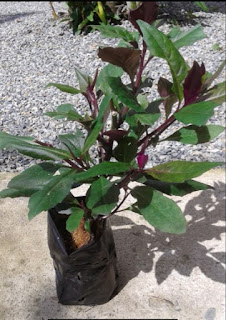 Okinawa Spinach is a great perennial green with many names. They include Gynura
bicolor, gynura nepaliensis, gynura crepioides, cholesterol spinach, dawn dewa,
leaves of the gods, Mollucan spinach, handama, gynura, hung tsoi, purple
spinach, red vegetable, Okinawa lettuce
Okinawa Spinach is a great perennial green with many names. They include Gynura
bicolor, gynura nepaliensis, gynura crepioides, cholesterol spinach, dawn dewa,
leaves of the gods, Mollucan spinach, handama, gynura, hung tsoi, purple
spinach, red vegetable, Okinawa lettuce
--
--
NEEDS- Tropical or subtropical climate. Wet conditions. However, although it prefers warm tropical conditions, it can be frost tolerant as it will survive frost if mulched.
- Yellow / orange flowers may be removed to encourage bigger and healthier leaves
- Loves nitrogen, including blood meal (ie a nitrogen rich natural fertilizer made from dry blood. However, since blood meal is usually a by-product from the slaughter house of cattle or hogs, consider this environment and animal friendly source of blood meal.)
- For thicker foliage, harvest by pruning the top shoots (ie rather than picking leaves) to promote more thicker growth … and to prevent weeds. See illustration images below. Can you see in this video the new side branches of an okinawa spinach plant will be ideal for propagation. -- --
- Moist soil
- Not picky regarding pH, soil type (whether clay or silt), light conditions (shade or sunlight) or environment (whether in pots or directly in the ground)
- Spacing of roughly 60 cm
- Is not a heavy feeder. However, it is advisable to feed it compost at least once yearly if the soil is sandy.
....==> BUY TROPICAL ORGANIC TEA LEAVES <==
- Human food containing many vitamins (both varieties). Younger leaves are tastier than older ones. Younger leaves can be consumed raw in salads and smoothies. However, note that the more leaves you add to smoothies, the more foamy the drink will become. The purple variety has a stronger flavor. However, you can cook either the younger or older leaves. Typical ways of cooking include steaming, stir-frying, tempura, or in soups and stews. However, note that, when cooked, the leaves are mucilageneous (like okra). Cooking time enhances this quality. Consequently, if you want to avoid this effect, add the leaves at the end of cooking. Additionally, note that, when overcooked, the purple variety loses its color.
- Anecdotal claims that it lowers cholesterol
- Ground cover. As pictured below, if well-pruned, it can spread and provide thick foliage that can prevent weeds from growing. (Example, it can be planted around taller plants like eggplant)
- Garden bed edges (because it is short)
- Flowers can attract bees and butterflies. However, you might want to harness this yield only if you have enough plants since this plant produces less and smaller leaves when flowering.
- As an extra input in fermented vegetables.-
CHARACTERISTICS
· Low maintenance
· There are 2 varieties; the
all-green variety is considered less ornamental and considered more as the food
variety among the 2. However, both are edible. The purple variety is useful for
bringing color to food.
· Perennial leafy vegetable
· Spreads if the soil is
sufficiently moist. However, it is not overly aggressive.
· Can handle severe pruning as illustrated below.
· Grows up to 1 to 2 feet tall
· Rarely produces seeds
· Mostly pest free. White flies
and mites might attack during hot Summer periods. Leaf miners may attack but
unlikely to be to the point of being a major infestation.
· Propagation is easy
o 10-20 cm cuttings root in water
after a few weeks
o Cuttings can be stuck into
moist soil to roughly half its length. However, cuttings have a better chance
of survival if rooted in water before planting into the ground. (The specimen pictured immediately below was propagated this way.)
 |
| Okinawa spinach recently pruned (Image taken mid-September 2017). Propagated by sticking cutting directly into earth until the bottom of the cutting touched the bottom of the bag. |
 | |
|
--
--
 |
| Okinawa spinach (image taken 21 October 2017). Already I can get some fresh cuttings for propagating this perennial green. BTW, I have been harvesting from the top. |
CONTENT RELATED TO GROWING OKINAWA SPINACH
- Alternative greens are a great source of healthy food. Cut your food bill even further and get healthy. The options may surprise.
- Other ground cover plants
- Okinawa spinach is great as a thick low hedge with a natural looking but permanent garden edge
- See this free environment and animal friendly source of blood meal for your okinawa spinach.
- See a playlist of videos related to tropical organic gardening.
- Click HERE to subscribe to our YouTube channel (Naturopathic Control) for more on tropical organic gardening and natural health
No comments:
Post a Comment